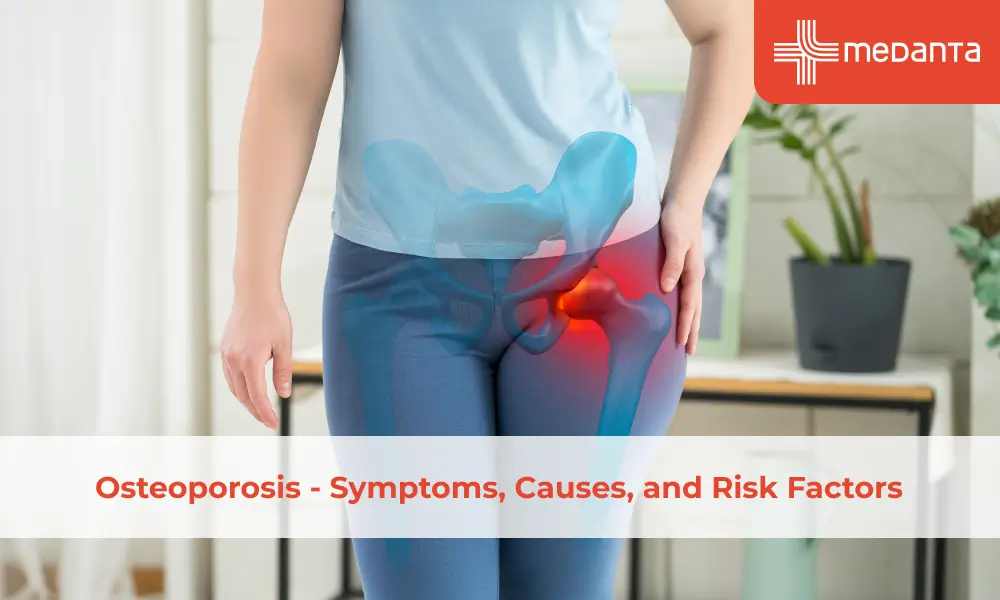Osteoporosis - Symptoms, Causes, and Risk Factors

TABLE OF CONTENTS
Bones add support and shape to the body. Their strength varies from one person to the other and depends on nutrition, lifestyle, and other factors. Sometimes they become so brittle and weak that they break due to simple day-to-day activities like coughing or bending. Often, it happens due to osteoporosis which is a medical condition that primarily affects the bones in the spine, wrist, or hip region of the body.
When an existing bone breaks down, a new one replaces it. This is a natural process that happens throughout the lifespan of an individual. But a problem arises when an existing bone breaks down and no new bone replaces it. In medical terms, this condition is referred to as osteoporosis.
Osteoporosis affects people from both genders and all races. However, women from certain races and regions are more vulnerable to it which includes Asian women and those who undergo menopause. Women from these categories have a higher likelihood of developing the symptoms of osteoporosis in comparison to those who belong to other races or regions. The treatment of osteoporosis involves medicines, proper nutrition involving a balanced diet, and some weight-carrying exercises.
Osteoporosis Symptoms
Osteoporosis is one of those medical conditions that are difficult to detect at the early stages of its onset. Though the weakening of bones is the primary indicator of the condition, it is a common one and can happen due to several other factors. The common signs and symptoms of osteoporosis include the following:
A collapsed or fractured vertebra that causes back pain
Reduction in height over time
Loss of a straight or the usual posture
A brittle bone that breaks easily
What Causes Osteoporosis?
One of the primary reasons for osteoporosis is the loss of bone mass which happens due to aging. The renewal of bones is a natural process of the body in which the existing bones are replaced by new ones when they break. It happens naturally in most individuals until they are 20 years old. An individual usually reaches the peak point of this process at the age of 30 years. Ageing gradually slows down this process. In the late 30s, people lose their bone mass at a quicker pace than the one at which it is created.
Your likelihood of developing osteoporosis will depend on the bone mass you had in your youth. To a large extent, it will depend on your genetics and ethnicity. A higher bone mass will ensure the availability of more bones in your body which will reduce or minimize your likelihood of developing osteoporosis, especially when you go older.
Risk Factors of Osteoporosis
Many risk factors increase the risk of developing osteoporosis. Apart from other medical conditions, their treatments, lifestyle choices, age, and race, such factors also include some unchangeable risks. Overall, the following risk factors are responsible for the development of osteoporosis:
Your gender
Your age
Your race
Family history
The frame size of your body
In addition to these factors, some other factors may also lead to the development of the condition.
Too high or too low level of sex hormones
Thyroid problems
Other glands
Low intake of calcium
Eating disorders
Gastrointestinal surgery
Long-term use of certain medications and steroids
Cancer
Liver disease
In some individuals, wrong lifestyle choices can also lead to the development of osteoporosis. For instance, people who take an uncontrolled amount of alcohol and do not have much movement or workout throughout the day are at risk of showing the signs and symptoms of osteoporosis. It can also happen due to excessive use of tobacco as using it continuously weakens bones.
Complications of Osteoporosis
The most serious complication of osteoporosis is a bone fracture. Apart from it, the medical condition can also lead to a fracture in the hip. In most cases, it either leads to a disability or even the death of an individual in the first year itself. This apart, osteoporosis also causes back pain and weakens the spine to the point in which it may even collapse.
Osteoporosis Treatment
The treatment of osteoporosis is centred on nutrition or diet and regular exercise. Those who do not get sufficient calcium from their diet are given calcium supplements to fulfil the requisite amount of calcium needed in the body. Orthopaedic Doctors provide special care to keep the level of calcium just about perfect in the body as its excessive level in the body can put an individual at risk of developing heart disease.
Other than calcium, vitamin D from sunlight and supplements also improve the condition of an individual who suffers from osteoporosis. Among exercises, the recommended ones include exercises that primarily focus on building strength and correcting the balance of bones.






